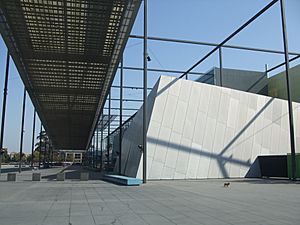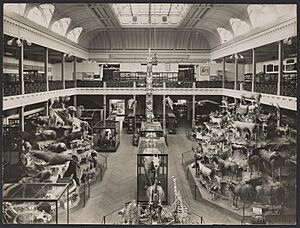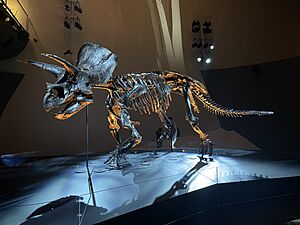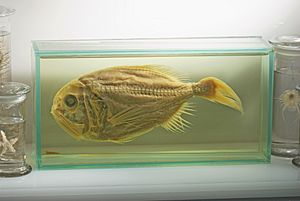Melbourne Museum facts for kids

Melbourne Museum in the Carlton Gardens
|
|
| Established | 1854 |
|---|---|
| Location | Carlton, Victoria, Australia |
| Type | Natural and cultural history museum |
| Owner | Museums Victoria |
| Public transit access | Tram routes 86, 96 |
The Melbourne Museum is a super cool place to explore natural history and different cultures. It's located in the beautiful Carlton Gardens in Melbourne, Australia.
This museum opened in 2000 and is right next to the famous Royal Exhibition Building. It's managed by Museums Victoria, which looks after many important collections.
The museum even won an award for Best Tourist Attraction in Australia in 2011!
Inside, you'll find amazing galleries and special areas like Curious?. Here, you can meet staff and learn about the museum's collections and how they work behind the scenes. There's also a cafe and a gift shop. The museum holds over 17 million items, including things from Indigenous Australian and Pacific Islander cultures, rocks, old tools, palaeontology (dinosaur stuff!), and animals. It also has a huge library with old science books. Plus, it's home to one of the world's biggest IMAX movie screens, where you can watch awesome documentary films in 3D!
Contents
Amazing Architecture
The Melbourne Museum building is a modern and unique design by architects Denton Corker Marshall. It was finished in 2001, and the museum officially opened in 2000.
The building is designed so you can easily find your way around. It feels like a single building, but also like several buildings connected together within the Carlton Gardens.
The museum's design fits well with the nearby Royal Exhibition Building and even the tall skyscrapers of Melbourne city. A special feature of the design is its long, high, sloping roofs, which look like giant blades.
These "blades" guide visitors from the street right into the museum's entrance. On the northern side, another large blade-like roof rises up, similar in size to the dome of the Royal Exhibition Building.
The museum is in a great spot, close to a big landmark in a large public park. Even though it looks very different from the old Royal Exhibition Building, they are connected underground by a car park. The museum's design also includes a special Forest Gallery inside, which brings the outdoors indoors!
Museum History
Early Days: La Trobe Street
The museum first started way back on March 9, 1854, in a place called the Government Assay Office on La Trobe Street. In 1858, Frederick McCoy, a professor from the University of Melbourne, became the first Director of the National Museum.
For a long time, the Melbourne Museum was in the city center, sharing a block with the State Library of Victoria. The nearby train station, now called Melbourne Central railway station, was even named after it! Later, the State Library took over the whole building, and the museum moved to its current location.
During the 1970s, there was a lot of planning to create a single, large museum complex in Melbourne. This planning eventually led to the idea of building the new Melbourne Museum in Carlton.
New Home: Carlton Gardens
The current Melbourne Museum in Carlton Gardens opened on October 21, 2000. It was built on the site of an old car racing track.
When the new museum opened, it included some living things in its exhibits. The most famous example is the Forest Gallery, which is a real-life temperate forest from eastern Victoria, right inside the building! This gallery has an ongoing exhibition called "Forest Secrets," which teaches you about how forests change.
The Melbourne Museum was also a venue for Festival Melbourne 2006, an art festival held during the 2006 Commonwealth Games. It hosted cool exhibitions like "Common Goods," which showed crafts from different Commonwealth countries, and "CARVE," where artists demonstrated traditional carving. There was even a market selling local food and a cooking competition!
Main Exhibits
Here are some of the awesome main exhibits you can explore:
- Science and Life Gallery – This is the museum's natural history section.
* Dinosaur Walk – See amazing fossil skeletons of dinosaurs like Tarbosaurus and Triceratops. * 600 Million Years: Victoria Evolves – Discover more prehistoric animals, including some that lived in Victoria. * Dynamic Earth – Learn all about geology and how our planet works. * Bugs Alive! – Get up close with live and preserved insects and other invertebrates. * Marine Life: Exploring our Seas – Dive into the world of ocean creatures. * See a giant skeleton of a pygmy blue whale. * Horridus – This exhibit, which opened in 2022, features the most complete Triceratops fossil ever found! It's super impressive.
- Melbourne Gallery – See the famous mounted hide of champion racehorse Phar Lap.
- The Melbourne Story – Learn about the history of Melbourne, from its early days to now.
- Forest Gallery – Step into a living temperate forest environment, complete with real birds, reptiles, and other animals.
- Bunjilaka Aboriginal Cultural Centre – Explore galleries with exhibitions created by and about the Aboriginal peoples of Victoria.
- Te Vainui O Pasifika Gallery – This exhibition shows the history and amazing boats of Pacific Islanders.
- The Pauline Gandel Children's Gallery – A fantastic hands-on area for younger kids (0 to 5 years old) to learn through play.
- Touring Hall – This is where special international exhibitions are shown. For example, "A Day In Pompeii" was a very popular exhibition here in 2009.
IMAX Melbourne
The IMAX Melbourne cinema is located beneath the Melbourne Museum. It first opened in 1998 with what was then the world's largest screen.
Museums Victoria has owned and operated the cinema since 2004. In 2013, the cinema was updated with a new 4K Laser projection system and an improved sound system. The screen was also made even bigger!
When the IMAX Sydney cinema was taken down in 2016, IMAX Melbourne became the largest operating IMAX screen in the world. It held this title until a new IMAX opened in Leonberg, Germany, in 2021.
Even with new cinemas opening, IMAX Melbourne is still the largest IMAX in the Southern Hemisphere. It has a huge screen and can seat 461 people, including special VIP seats!
Awards and Recognition
The Melbourne Museum has won many awards for its design and as a tourist attraction. It received the RACV Award for major tourist attraction, welcoming over 1.4 million visitors between 2010 and 2011.
In March 2012, the museum was recognized at the Qantas Australian Tourism Awards. Its Science and Life gallery also won the Large Permanent Exhibition Award. The museum has also received awards from the Royal Australian Institute of Architects for its amazing building design.
See also
- H. L. White Collection
Gallery











